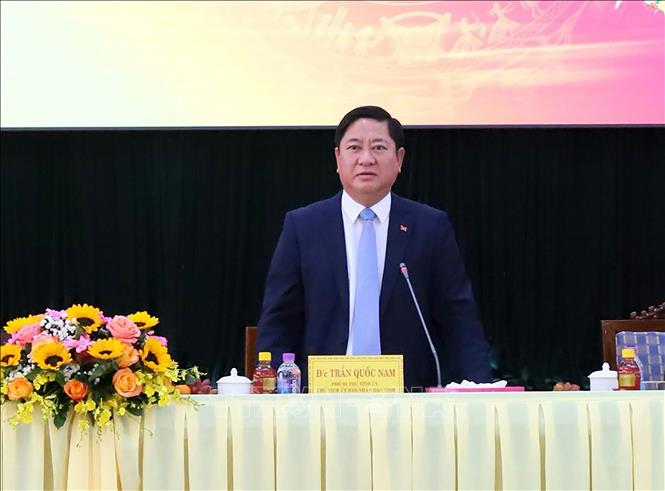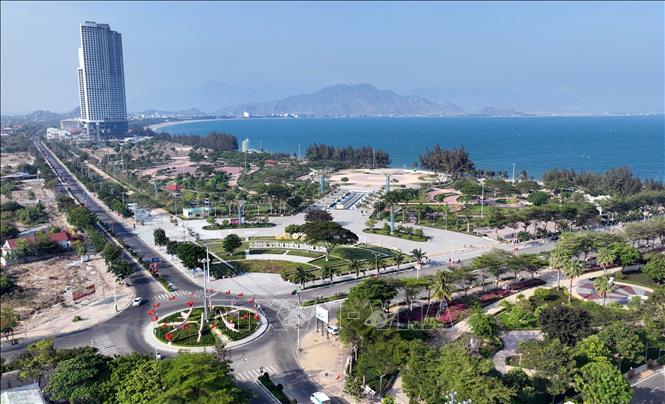
Mr. Tran Quoc Nam, Chairman of Ninh Thuan Provincial People’s Committee.
After more than two years of implementation, on November 10, 2023, the Provincial Planning was approved by the Prime Minister in Decision No. 1319/QĐ-TTg. In order to clarify the viewpoint, purpose, and implementation solutions, as well as the expectations for the new development of “Ninh Thuan – The land of convergence of different values,” TTXVN reporters interviewed Mr. Tran Quoc Nam, Chairman of the Provincial People’s Committee, on this issue.
Mr. Chairman, it is known that on April 28, the province will organize a Conference to announce the Provincial Planning for the period 2021 – 2030, with a vision to 2050. Can you share the province’s viewpoint, purpose, and expectations after this event?
Ninh Thuan will organize a Conference to announce the Provincial Planning for the period 2021 – 2030, with a vision to 2050, in conjunction with investment promotion in the locality, aiming to provide basic information on the Provincial Planning; introduce and promote the image, potentials, advantages, preferential policies, and development orientations to domestic and foreign investors; create a spillover effect, and mobilize the best resources to exploit the province’s potential and strengths in order to realize the Planning.
The province’s Planning sets out a new scenario with a strategic vision: “Ninh Thuan – The land of convergence of different values.” Accordingly, Ninh Thuan aims to strive to become a province with a per capita income in the upper-middle group of the country by 2030; and by 2050, to develop comprehensively, rapidly, and sustainably, with a diverse and prosperous economy, improving the material and spiritual life of the people; and ensuring a solid national defense and security.
Could you please elaborate on the content of the provincial planning during this period?
The Provincial Planning for the period 2021 – 2030, with a vision to 2050, was approved based on a scenario of achieving an average growth rate of 10 – 11%/year in the next ten years. To achieve this goal, the province will inherit the methodologies and research approaches of the previous model, using the diamond model but integrating resources and incorporating new theories and models such as the circular economy, inclusive economy, and sharing economy, ensuring that the Provincial Planning meets development needs and is consistent with current global development trends.
Based on this, the province has identified five key breakthrough sectors that will drive growth, including: Energy, renewable energy; high-quality tourism; processing and manufacturing industry; high-tech agriculture; and construction and real estate market. These are five sectors with potential, comparative advantages, and high competitiveness, in line with the policies, orientations, and strategies of the country and the region in the coming period. At the same time, the province has identified two new growth drivers: the maritime economy and the urban economy, in line with the strategy for sustainable development of Vietnam’s maritime economy to 2030, with a vision to 2045, and Resolution No. 26-NQ/TW, dated November 3, 2022, of the Politburo on “Socio-economic development and ensuring national defense and security in the North Central and South Central Coast regions to 2030, with a vision to 2045.” Ninh Thuan places people as the core of development and as the driving force, goal, and resource for ensuring the socio-economic development of the locality.
In terms of spatial development planning, the province will organize socio-economic activities according to four territorial regions, three dynamic regions, and three development corridors. In which, the dynamic urban area of Phan Rang – Thap Cham will develop comprehensively and multi-sectorally; the key economic zone in the south of the province, aiming to establish a national coastal economic zone, prioritizing the development of industry – seaports – energy, trade services, and tourism. The western region will develop trade services, high-tech agriculture, energy, and tourism.
In this planning, the locality also identifies the key economic zone in the south as a new growth pole, which is an important driving force for exploiting the province’s potential and advantages in seaports, dry ports, logistics service centers, industrial parks, urban areas, tourism, LNG Ca Na power plant, etc.; by 2030, the southern dynamic region will contribute 50 – 51% of the province’s GRDP.
At the same time, the province will focus on investing in developing inter-regional, multi-purpose, and modern infrastructure; in which, the breakthrough is in developing transportation infrastructure connecting expressways, Ca Na general port to the Central Highlands provinces; seaport and logistics infrastructure, transmission infrastructure, industrial parks, tourism, and airports, creating a driving force for development.

The coastal strip of Ninh Thuan province is attracting businesses and investors in the tourism sector.
Could you please share the province’s solutions for attracting investment resources and boosting development in the coming period?
In the coming period, the Provincial People’s Committee will continue to strongly improve the investment and business environment, invest in infrastructure, and implement policies to encourage and support businesses in order to enhance the province’s competitiveness in attracting investment. Specifically, the province will focus on investing in completing infrastructure to increase regional connectivity, promote the effectiveness of the local transportation system, and develop the socio-economy, such as: Thanh Son Airport; Ca Na general seaport infrastructure; railway line connecting Ca Na station to the seaport; transportation system connecting the port to the inter-regional road to the Central Highlands provinces; Thap Cham – Da Lat railway; dry port and Class II Logistics Center.
At the same time, the locality will continue to implement administrative procedure reform in order to create a more convenient investment environment for investors; and continue to cut down on the time it takes to process investment registration procedures compared to the total time stipulated.
The province will apply investment policies in a way that ensures the best interests and the simplest administrative procedures for investors with projects in the locality. Accordingly, Ninh Thuan will apply the highest level of incentives within the framework of the State’s regulations on land lease, land allocation, corporate income tax, and import tax in accordance with the Investment Law, Land Law, Corporate Income Tax Law, and Import and Export Tax Law. In which, all the districts of the province belong to the locality with special socio-economic difficulties and enjoy the highest level of investment incentives. Phan Rang – Thap Cham City belongs to the locality with socio-economic difficulties, and applies the investment incentives for the locality as stipulated in the Investment Law of 2020 and Decree No. 31/2021/ND-CP dated March 26, 2021, providing detailed regulations and guidelines for the implementation of a number of articles of the Investment Law.
For investment projects in agriculture and rural areas, Ninh Thuan Provincial People’s Committee will issue a number of special policies to encourage businesses to invest in agriculture and rural areas and a policy to support attracting investment in high-tech agriculture in the province for the period 2021-2030. These policies include regulations on the levels of support from the State budget for activities of scientific and technological application research in high-tech agriculture; investment production activities; research on new varieties, etc.
In addition, the Provincial People’s Committee will have policies to support investment in projects in industrial parks. Specifically, for the construction of infrastructure in Phuoc Nam, Du Long, and Ca Na industrial parks, investors will be exempted from paying land rent for the entire period and will enjoy a preferential corporate income tax rate of 10% applied for 15 years from the start of production and business operations; exemption from tax for four years from the time of having taxable income and a 50% reduction in tax payable for the next nine years (applicable to secondary projects investing in the three above-mentioned industrial parks).
After the Planning is announced, what is the province’s orientation for linking and developing with provinces and cities in the region and the whole country in order to create a driving force for rapid and sustainable development?
Ninh Thuan determines that linkage and












